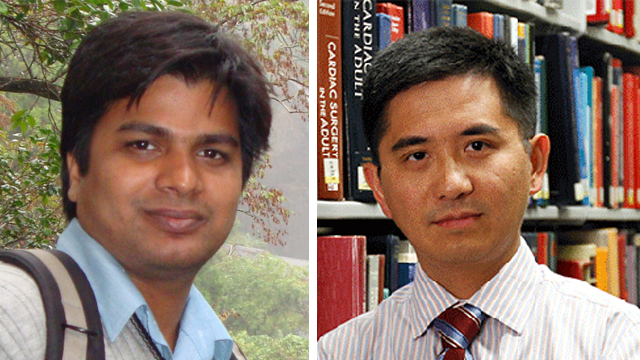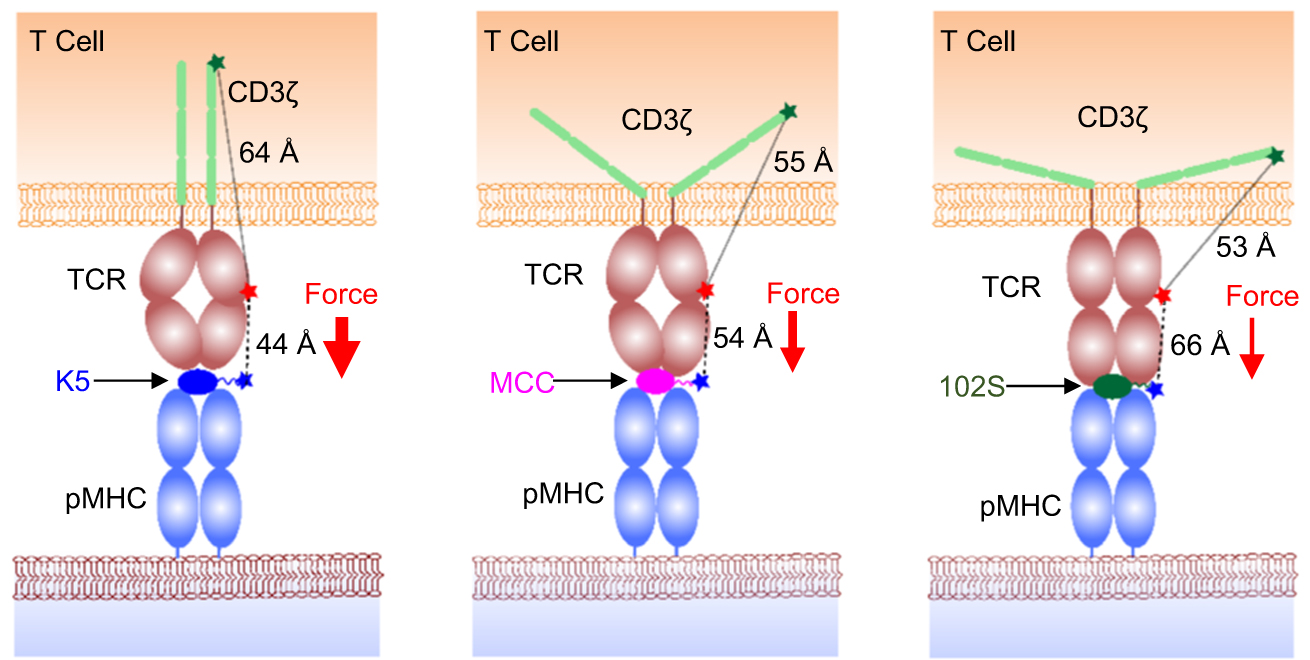October 21, 2019 | Jola Glotzer
Do you know how T cells discriminate between foreign and self-antigens?
Check out the recent publication in Cellular & Molecular Immunology reporting on the results from research partially sponsored by two CBC Awards!

CBC Postdoctoral Research Award (2016) recipient Dibyendu Sasmal, UChicago (left), is first author on the Cellular & Molecular Immunology publication. His mentor, Jun Huang, UChicago, is senior author and a CBC Catalyst Award (2017) recipient.
T cells are constantly challenged by a plethora of antigens carried by the antigen presenting cells (APC) in the form of peptide-loaded major histocompatibility complexes (pMHC). To trigger an antigen-specific immune response, a T cell receptor (TCR) must encounter a specific pMHC, initiating signal propagation from the surface TCR binding to its intracellular counterpart, CD3, resulting in the CDC subunit (TCR–CD3ζ) phosphorylation.
However, how exactly does a TCR recognize which antigen is non-specific (an organism’s self-peptide) and which is a foreign one requiring an immediate T cell response to fight the intruder?
This million-dollar question is considered in a recent Cellular & Molecular Immunology publication “TCR-pMHC bond conformation controls TCR ligand discrimination.” Using highly sensitive in situ fluorescence resonance energy transfer (FRET) the authors measure the intermolecular distances of individual TCR–pMHC bonds and the intramolecular conformations of corresponding TCR–CD3 receptor complexes at the membranes of live T cells in real time and with high (subnanometer) spatiotemporal resolution. Based on the measurements obtained for different classes of antigens, the authors suggest a compelling model underlying the molecular mechanism of TCR ligand discrimination.
A CBC Postdoctoral Research Award (2016) recipient, Dibyendu Sasmal, UChicago, is first author on the Cellular & Molecular Immunology publication. His mentor, Jun Huang, UChicago, is senior author and a CBC Catalyst Award (2017) recipient. Both CBC Awards are acknowledged as having contributed funding to the published research. Jun Huang, PhD, is Assistant Professor in Molecular Engineering at the UChicago Pritzker School of Molecular Engineering. Dibyendu Sasmal, PhD, is a postdoctoral scholar in Huang’s lab.
In addition, CBC Accelerator Award Review Board member, Erin Adams, PhD, Joseph Regenstein Professor at the Department of Biochemistry and Molecular Biology at UChicago, is second senior author on the study.
The CBC congratulates all authors involved in this fascinating research and thanks Adams for her time and dedication in supporting the CBC programming.
Publication attributed to *CBC funding:
*Sasmal DK, Feng W, Roy S, Leung P, He Y, Cai C, Cao G, Lian H, Qin J, Hui E, Schreiber H, Adams EJ, **Huang J. TCR-pMHC bond conformation controls TCR ligand discrimination. Cell Mol Immunol. 2019 Sep 17. [Epub ahead of print] (PubMed)
ABSTRACT:

Proposed model for TCR ligand discrimination. The TCR–pMHC bond conformation controls the TCR–CD3ζ distance to regulate the exposure of ITAMs on CD3ζ for subsequent phosphorylation for the K5, MCC, and 102S pMHCs, respectively. (Source: Cell Mol Immunol.)
A major unanswered question is how a TCR discriminates between foreign and self-peptides presented on the APC surface. Here, we used in situ fluorescence resonance energy transfer (FRET) to measure the distances of single TCR–pMHC bonds and the conformations of individual TCR–CD3ζ receptors at the membranes of live primary T cells. We found that a TCR discriminates between closely related peptides by forming single TCR–pMHC bonds with different conformations, and the most potent pMHC forms the shortest bond. The bond conformation is an intrinsic property that is independent of the binding affinity and kinetics, TCR microcluster formation, and CD4 binding. The bond conformation dictates the degree of CD3ζ dissociation from the inner leaflet of the plasma membrane via a positive calcium signaling feedback loop to precisely control the accessibility of CD3ζ ITAMs for phosphorylation. Our data revealed the mechanism by which a TCR deciphers the structural differences among peptides via the TCR–pMHC bond conformation.
ACKNOWLEDGMENTS:
We thank Mark M. Davis at Stanford for providing the constructs for the anti-TCR scFvs, Michael Birnbaum at MIT for providing the IEk plasmids, Xiaolei Su and Marcus Taylor in the lab of Ronald Vale at UCSF for advice regarding the preparation of the glass-supported lipid bilayer, Jillian Rosenberg for reading the manuscript, and the NIH Tetramer Core Facility for providing the pMHC monomers. This work was mainly supported by NIH grants R00AI106941 and R21AI120010, NSF CAREER Award 1653782, a Chicago Biomedical Consortium Catalyst Award (to J.H.) and postdoctoral grant PDR-092 (to D.K.S.), with additional support from the Searle Funds at The Chicago Community Trust. This work is also supported by NIH grant R01AI126756 (to E.J.A.) and R01CA022677 (to H.S.).
Featured CBC Community member(s):
Dibyendu Sasmal and Jun Huang, UChicago
- *CBC Postdoctoral Research Award (2016):
▸ Direct Observation of T Cell Activation by Lattice Light-Sheet Microscopy
PIs: Dibyendu Sasmal (postdoc) and Jun Huang (UChicago) - **CBC Catalyst Award (2017):
▸ Novel single-cell analyses of tumor-specific T cells in Merkel cell carcinoma
PIs: Jaehyuk Choi (NU) and Jun Huang (UChicago)
Erin Adams, UChicago
- CBC Accelerator Review Board (2018—present):
▸ Current membership
Erin Adams (UChicago) — Board Member - CBC Postdoctoral Research Award (2014):
▸ Determining the small molecule repertoire presented by MR1 to MAIT cells
PIs: Cara Froyd (postdoc) and Erin Adams (UChicago) - CBC Postdoctoral Research Award Reviewer (2014—2016):
Erin Adams (UChicago) — Ad hoc reviewer - CBC Scholar Award (2012—2013):
▸ Meet the Scholar Gregory Tietjen
PIs: Gregory Tietjen (graduate student) and Erin Adams and Ka Yee Christina Lee (mentors; UChicago)
